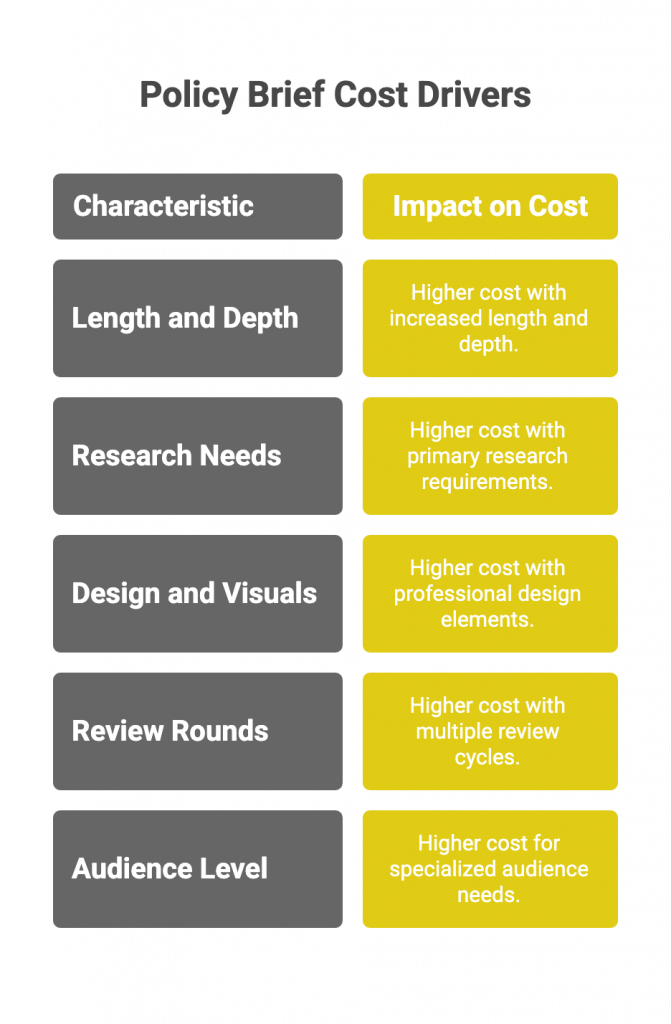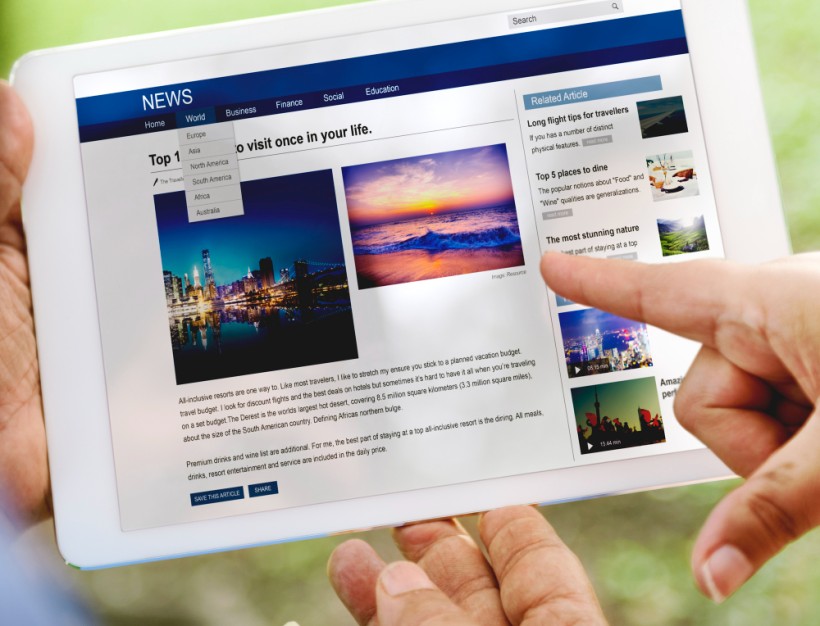If you’ve ever tried to commission a policy brief, you’ve probably noticed one thing fast: prices are all over the place. Some freelancers charge $300. Some agencies quote $2,000 or more. And if you ask three different writers, you’ll get three very different numbers. So let’s break it down.
A policy brief is a short document that helps decision-makers understand a specific issue and what actions to take. It’s meant to be short, focused, and backed by evidence. But how much it costs depends on what you need it to do.
The average cost of a policy brief
If you’re working with an experienced freelance writer, expect to pay somewhere between $400 and $1,200. Agencies and research consultancies usually charge more, often between $1,500 and $3,000, depending on research depth and design. These costs are for English-language briefs; rates can shift slightly depending on region or language translation needs.
| Type of provider | Typical range | What you get |
| Freelancer | $400–$1,200 | Writing only, using your existing data |
| Agency | $1,500–$3,000 | Research, design, writing, and reviews |
| In-house staff | Time-based cost | Variable depending on expertise |
The biggest factor is how much original research or synthesis you expect. If you already have the research done and just need it shaped into a clear 4-page document, it’ll cost less than commissioning a writer to find, analyze, and interpret new data.
Policy briefs are not blog posts. They need both structure and clarity. Many organizations underestimate the time it takes to produce one properly. Between drafting, reviewing, and formatting, even a simple brief can take 20–40 hours of total work. Once you start adding custom visuals or multiple stakeholder reviews, the time—and cost—rises sharply.
What drives the cost of a policy brief
A few things explain why prices vary so much:
Length and depth
A 2-page policy brief summarizing a single issue is much cheaper than a 10-page report comparing multiple policy options. The longer the brief, the more time is needed to write, check sources, and maintain clarity. For instance, a 1,200-word document focused on one issue might cost $600, while a 3,500-word brief covering multiple policy pathways could be closer to $1,800.
Research needs
Some briefs are built entirely from desk research. Others need interviews, data collection, or stakeholder analysis. The latter takes more time and expertise. For example, if you’re working on a climate adaptation policy, you might need to reference recent IPCC data or local vulnerability assessments—both of which require data verification and synthesis.
Design and visuals
Good design helps policymakers skim and absorb key points quickly. But design is rarely included in a base writing quote. If you want your brief to include infographics, charts, and layout aligned with your brand, expect to add $150–$500 for professional formatting.
Review rounds
Each revision costs time. The more stakeholders involved, the higher the total price. A single policy brief might go through four or five review cycles—internal team review, partner organization input, external expert check, and final proofreading. Each cycle adds a few hours of work.
Audience level
Writing for a ministry or donor agency requires a higher level of precision and validation than a university class project. Writers who understand development policy, economics, or social impact charge more because they can ensure accuracy, tone, and contextual relevance. A generalist writer may be cheaper, but your end product might lack the nuance policymakers expect.

Policy brief cost examples
Let’s look at some typical scenarios:
| Type | Description | Estimated cost |
| Simple brief | You provide all data, need 2–3 pages of clean writing | $400–$700 |
| Mid-level brief | Writer does light desk research and adds visuals | $800–$1,200 |
| Full-service brief | Includes interviews, new data, design, and multiple edits | $1,500–$2,500+ |
If you work with an agency that handles both writing and design, you’ll usually receive a print-ready PDF along with an editable file. If you hire separately—a writer for the content and a designer for layout—factor in coordination time between both parties.
How to reduce cost without cutting quality
If you’re working with a tight budget, a few things help.
First, be clear about your scope and provide your existing materials upfront. The more clarity you give the writer, the fewer revisions later. Most writers charge extra if they need to chase details or reorganize content midstream.
Second, provide your own visuals or charts if you can. That saves design time. You can create simple graphs using tools like Datawrapper (https://www.datawrapper.de/) or Flourish (https://flourish.studio/). These tools make it easy to export clean visuals without needing a designer.
Third, work with writers who already understand your sector. They’ll need less time getting up to speed. For instance, a writer familiar with agriculture policy won’t need to read 10 background documents to understand the topic.
Fourth, keep your review process tight. Limit the number of reviewers and consolidate feedback. Each additional reviewer adds time and complexity.
Finally, set realistic timelines. Rush projects usually cost 20–30% more because the writer or agency needs to prioritize your work ahead of others. Planning ahead saves money.
If you need data sources, you can explore open repositories like the World Bank Data Portal, the OECD Data site, and Our World in Data. They often have datasets you can cite or visualize without licensing fees.
What to look for in a policy brief writer or agency
Experience matters a lot. You want someone who can translate complex findings into plain, actionable language. Ask for samples of past briefs, especially in your field. A strong sample usually reveals whether the writer understands policy framing, tone, and structure.
Check whether they’ve worked with reputable institutions. Someone who’s written for the UN, a government department, or a think tank is more likely to understand the nuance of policymaking and how decision-makers read documents.
Ask about the process: how many drafts, how long for each stage, and what’s included in the price. Transparency upfront helps avoid conflict later.
If you’re hiring an agency, confirm whether the price includes design, revisions, and formatting for publication. Some charge separately for that. Also, ask about references or client feedback.
Here’s what a transparent quote should show:
| Element | What it covers | Included? |
| Writing | Drafting based on brief and research | Yes |
| Research | Desk review or interviews | Sometimes |
| Editing | Two rounds of revisions | Usually |
| Design | Layout, visuals, branding | Optional |
| Proofreading | Grammar and style check | Usually |
Regional differences in policy brief costs
Rates vary depending on where your writer or agency is based. Writers in North America or Europe often charge more than those in Africa or Asia. However, regional rates don’t always mean lower quality. Many skilled writers in Kenya, Nigeria, or India produce top-tier briefs for international organizations. What matters more is specialization and clarity in expectations.
If you’re based in a country where currency fluctuations are common, consider quoting in USD or GBP to avoid confusion later.
When to invest more in a policy brief
There are cases when paying more makes sense. If your policy brief is going to be shared with ministries, donors, or the media, quality matters. Decision-makers often skim documents, so clarity, structure, and design directly influence whether your recommendations get noticed.
If your brief will anchor a new campaign, grant proposal, or advocacy push, invest in higher quality. It’s often the first impression of your organization’s credibility.
Common mistakes that waste budget
Many organizations spend more than they should because they underestimate the process. Here are a few common errors:
- Starting without a clear objective. Writers need to know what decision you want to influence.
- Providing too much or too little data. Dumping a 100-page report without a summary wastes time.
- Involving too many reviewers. Conflicting edits can double your timeline.
- Ignoring design. A great brief hidden in bad layout rarely gets read.
- Rushing at the last minute. Urgent projects almost always incur surcharges or express fees.
Example timeline and budget
A realistic workflow for a 6-page policy brief might look like this:
| Stage | Task | Estimated time | Cost range |
| Week 1 | Outline and research plan | 5 hours | $200 |
| Week 2 | Draft writing | 10–15 hours | $400–$800 |
| Week 3 | Review and edit | 5 hours | $200 |
| Week 4 | Design and layout | 5–8 hours | $250–$400 |
Total estimated cost: $1,000–$1,600 depending on scope and pace.
This timeline assumes moderate complexity and one round of stakeholder feedback. Complex projects with multiple data sources or reviews can double that.
Final thoughts
Policy brief cost planning isn’t just about word count. It’s about influence. The right brief can help shape a policymaking decision, attract funding, or shift a conversation. If you think about it that way, spending a bit more for quality writing and presentation isn’t just reasonable—it’s strategic.
If you’re planning your next policy brief and want a realistic quote, gather your research materials, outline your goal, and then ask for a scoped estimate. It’ll save both time and money. And if you’re building multiple briefs over the year, consider long-term relationships with one writer or agency—they’ll understand your tone, data sources, and policy angle better, which lowers costs over time.
Work with Column
At Column, we write policy briefs for global organizations that want to influence change through clear, evidence-based writing. Our team combines research depth with communication expertise, so your message lands with the people who matter. Whether you need a one-off policy brief or a full communications partner, we can help you plan, write, and design it from start to finish — and help you take action.
Get in touch to learn more or request a quote.
Mo is the founder and CEO of Column, helping leaders shape public opinion through content and research. Connect with him on LinkedIn.





